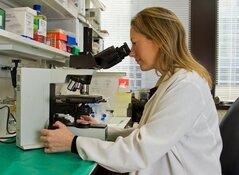
Today I’ll show you how an unlikely discovery — centered around Mosquitoes, of all things — could lead to a cure to one of the deadliest diseases of our time.
According to a leading US health organization, this deadly disease will kill seven and a half million people worldwide a year. Even if it doesn’t kill you, you have roughly a 40% chance of developing this disease at some point in your life.
Now, a unique team of professionals and students have created a novel technology that could start taking names off that long list of victims. And you have one of the most unlikely creatures to thank for it
But first, let me back up to the beginning…
Each living creature has unique survival techniques.
These amazing “innovations” are primarily of the physical kind. Humans cannot perform the same physical feats. For example, you can’t accelerate on foot from 0 to 64 miles per hour in three seconds, like the biological miracle of a cheetah. You’d need a super car for that. Examples of animals with such specialization are countless.
But on the other hand, you are gifted with a big brain. So feel good. It affords you the capacity to be a generalist. In this way, you yourself may already qualify as a kind of scientist, because you can observe more. Here’s what I mean…
Any animal’s survival techniques can be “borrowed” and turned into technology…
During the 1950s, the American biophysicist and polymath Otto Schmitt called this “biomimetics,” from the Greek bios (life) and mimetikos (imitative).
Schmitt shared the same workplace with Jack Steele, who coined the more familiarized term “bionics.” Schmitt said in the 1960s:
“Let us consider what bionics has come to mean operationally and what it or some word like it (I prefer biomimetics) ought to mean in order to make good use of the technical skills of scientists specializing in, or I should say despecializing into, this area of research.”
Whatever you want to call the approach, the point is any kind of creature alive today can inspire designs for tomorrow’s technologies. To prove and utilize this theory, let’s look at what is often considered one of life’s more useless and annoying creatures: the mosquito.
How in the world could this little pest affect your life… other than whiz in your ear, suck your blood, inflict an itchy bite, transfer a deadly disease… or meet a justified smack?
And how could it play a role in the marketplace?
At Virginia Tech, a team of professionals and students have evolved a discipline of “cancer engineering.” They’ve cross-pollinated ideas from the life sciences that normally wouldn’t work with one another: cancer biologists, veterinarians, physicians and engineers.
They’ve designed an instrument called a fiber-optic micro-needle device, or FMD.
It promises to search and destroy unwanted tissue, delivering cancer treatment directly into a tumor.
After it’s approved for clinical trials, it could serve as the basis for a whole series of experimental technologies.
“We know the mosquito can land on the human skin and insert their needle, their microneedle, several millimeters deep into skin. So we knew that the insertion of a very small-diameter needle was feasible based on nature’s example,” says mechanical engineer Christopher Rylander.
The FMD is the same size and shape as a mosquito’s stinger (40 microns — less than the width of a human hair). It’s so sharp that it can be easily inserted into your tissue with minimal surrounding damage, which means less invasiveness, bleeding and pain and quicker recovery times.
But here is where it get’s even more interesting…
This FMD is two cancer treatments combined into one medical device.
The team works with lesser-known optical therapy treatments, so the FMD injects fluids that deliver conventional chemotherapy drugs or nanoparticles. It can also deliver light from powerful lasers to destroy cancerous tissue.
Lasers inside the complex environment of a human body are not as precise as you might think. Light and tissue scatter, and the light delivered actually becomes very blurry because it doesn’t stay confined to the area around the delivery point. A good analogy is how an automobile’s headlights scatter out in a foggy night.
So the FMD is designed to control this scattering by delivering both light and light-absorbing nanoparticles at the same time.
The nanoparticles are injected into the tumor, and the light is absorbed exactly where it needs to be.
This provides a medium to “ferry” drugs across the cell membrane.
One of the main targets of the fiber optic needle is one of the most difficult forms of cancer: brain cancer. The problem with brain cancer is that tumors are rooted into tissue like weeds are rooted in dirt. If you cut them out, it tears up the “ground” inside your brain. But with the FMD, surgeons could potentially highlight the cancerous tissue with light-absorbing nanoparticles and then destroy it with pinpoint accuracy.
John Robertson, or “Dr. Bob” as he’s nicknamed, is the director of the Center for Comparative Oncology at Virginia Tech’s vet school. Dr. Bob and his wife have both personally dealt with cancer. He says the FMD could potentially go a long way:
“By the time that we see the more advanced forms of both bladder tumors and brain tumors in people, we’re past the point really where we’re going to do much to help them. The morbidity, mortality over the few years, three, four, five years, the amount of suffering, the things that happen to patients are just horrific… This device and the folks that are working with it and the things that we can do with it, the broad applications, are going to allow us to get at those advanced cases and offer these patients… some hope, some new ideas.”
Feasible ideas in breakthrough technologies can be the seeds of blooming wealth. But they must be vigilantly guided through the entrepreneurship process. In the words of inventor, entrepreneur, and author Ray Kurzweil (who learned this at an early age), “I quickly realized that timing was the most important thing to invention. Most inventions fail because the timing is wrong.” The correct timing that he refers to depends on the marketplace that’s ready to receive it. Fortunately, we’ve devoted a lot of resources to getting the timing and investment strategies just right for our readers. Click here to learn how to profit from a technology similar to the one discussed in this article, but with the advantage of commercial viability. It’s locked, loaded and ready to fire.
Sincerely,
Josh Grasmick
Penny Sleuth



































